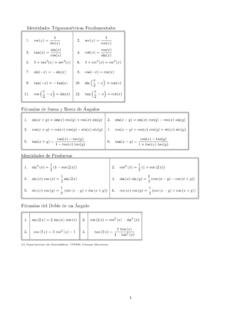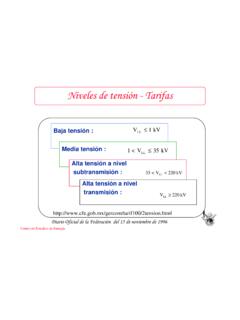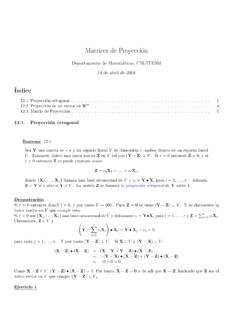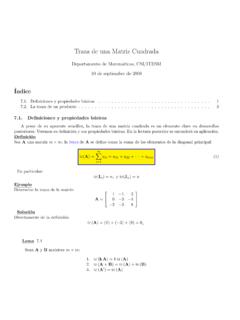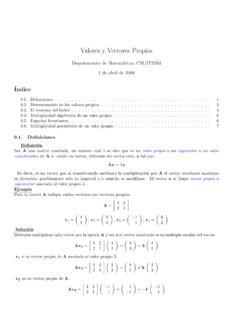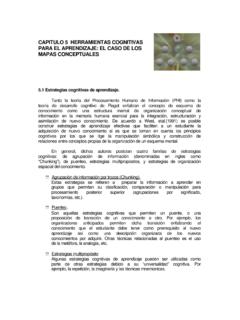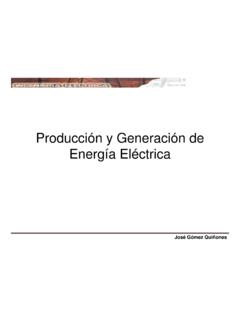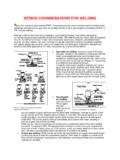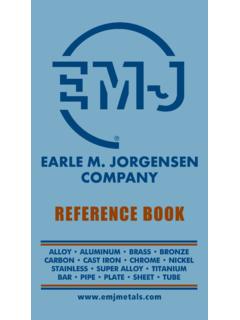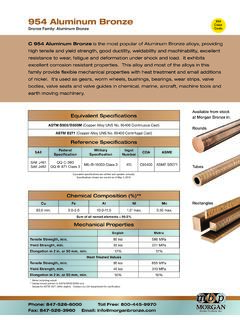Transcription of Ageing Heat Treatment of Aluminum Alloys - Tec
1 Mechanical Engineering Department Materials Engineering 2 Laboratory 1/9 Ageing Heat Treatment of Aluminum Alloys1 Content 1 Introduction .. 2 2 Age Hardening .. 3 3 Age Hardening of Aluminum Alloys .. 5 4 Procedure .. 7 Appendix A: Aging Characteristics of Aluminum Alloys .. 8 Appendix B: Heat Treatments for Aluminum Alloys .. 9 1 Adapted from: Callister, W.; Engineering and Science of Materials, Wiley and Sons, 1998; Askeland, D., La Ciencia e Ingenier a de Materiales, Iberoamerica, 1990; Mangonon, , Ciencia de Materiales: Selecci n y Dise o, Prentice Hall, 2001; and other sources. Mechanical Engineering Department Materials Engineering 2 Laboratory 2/9 1 Introduction The accidental discovery of precipitation hardening of Aluminum Alloys was discovered in Germany by Prof.
2 Alfred Wilm, when hardness tests were repeated on a Duralumin sample, an Aluminum -copper alloy, after it had been sitting on a laboratory bench for a while. When the test was repeated, a much higher hardness was observed. Researches, therefore, explained that the material had aged. The first name given to the phenomenon was that of aging hardening. Studies on this phenomenon showed that this also occurred in other alloy systems, and that the reason for hardening is the precipitation of a secondary phase from supersaturated solid solutions. Therefore, the correct name of the phenomenon should by hardening by precipitation , although it is still known in industry as age hardening . Further exploration of the phenomenon should, during the decade of the 1960 s, that the presence of the right sized precipitates actually disrupts dislocation flow.
3 Therefore, the phenomenon should be called precipitation strengthening or strengthening by precipitation . The actual scientific name is dispersion strengthening by secondary phase particles . In any case, the normal procedure to account for the properties change is carried out via the hardness test, reason why the generally accepted name is age hardening . The fundamental requirements for an alloy to be strengthened by the dispersion of secondary phase particles are the following (see Figure 1): a) A large maximum solid solubility at high temperature; that the alloy presents increasing solid solubility as the temperature increases. b) The alloy composition must be in between the maximum and the minimum solubility. c) That on quenching, the solid solution becomes supersaturated. This implies that the TTT curve of the alloy presents a feasible critical cooling rate to avoid diffusional transformations.
4 Since the quenched alloy (at room temperature) contains more solute in solution than indicated by thermodynamic equilibrium, it is a supersaturated, unstable solution that tends to precipitate the excess solute into a dispersion of secondary phase particles when heated slightly. Figure 1: Typical phase diagram of age hardening Alloys . Engineering Department Materials Engineering 2 Laboratory 3/9 2 Age Hardening Strengthening by a Dispersion of Secondary Particle A dispersion of secondary phase particles strengthens (and hardens) an alloy by hindering the flow of dislocations in various ways: Small particles produce coherency strain field: o As long as the particles are small they seek to maintain a close relationship with the lattice of the matrix, and this causes strain in the matrix that acts just as the strain fields of dislocations or other solutes.
5 Large incoherent particles: o As the particles grow, they lose coherency; and therefore, the strain field disappears. o If the particles are "hard , dislocations have to find ways to to surround them. Bowing Climbing Cross Slip o If the particles are "soft" dislocations tend to cut through them. Particles cutting also known as chemical hardening. The age hardening process Heat Treatment of nonferrous Alloys is generally performed at temperatures below the reaction temperature2. As seen in Figure 2, age hardening temperatures are lower than annealing temperatures, and well below the reaction temperature. In fact, the age hardening temperature has to be below the solvus temperature of the alloy in order to completely exploit the precipitation effect. Based on the requirements established in the above section, the heat Treatment process to achieve strengthening by the dispersion of secondary phase particles ( age hardening ) consists of the following 3 stages, illustrated in Figure 3: 1.
6 Solution Treatment : The term "solution" indicates that the alloy is heated to a temperature at which all the material becomes a single solid solution. This stage is also known as the homogenization Treatment (see Figure 4 for the A6160 alloy). 2. Quenching: To form a supersaturated solution the cooling rate must be greater than the critical cooling rate. This is most critical, otherwise the amount of solute in the supersaturated solution will decrease and the hardening effect will be significantly reduced. 3. Ageing : The hardening of the alloy is achieved by precipitating the excess solute into its equilibrium phase in the form of a transient, metastable and coherent precipitate. The hardening effect is due to the strain induced by the coherent precipitate. When the precipitation is done at room temperature, it is a natural aging; when it is done at higher temperatures, it is called artificial aging.
7 2 In many cases nonferrous Alloys , on the diluted side, are eutectic in nature. New Surface =Energy ConsumptionMechanical Engineering Department Materials Engineering 2 Laboratory 4/9 Figure 2: Typical temperature ranges Figure 3: Schematic illustration of the age for nonferrous alloy heat Treatment processes. hardening heat Treatment for nonferrous Alloys . Figure 4: The Al-Mg2Si Phase Diagram. TCReactionTemperatureAge HardeningAnnealingTTimeAgeingSolution Treatment5005205405605806006206406606807 000510152025 Temperature ( C)Composition (wt% Mg2Si)LL+AlAlAl+Mg2 SiL+Mg2 SiTypical A6160 CompositionMechanical Engineering Department Materials Engineering 2 Laboratory 5/9 3 Age Hardening of Aluminum Alloys The age hardening heat Treatment of Aluminum Alloys is generally a somewhat longer procedures at low temperature.
8 The hardening and/or strengthening effect of the precipitation process can be better explained by the curves in Figure 5. These aging curves show the changes in basic mechanical properties over time when heated at constant temperature to promote secondary phase particle precipitation. Note that peak hardness and strength is reached faster at higher temperatures, but the maxima is always lower than that for transformation at lower temperatures. This effect can be easily associated with average particle size and distribution. Figure 5a3: Effect of Ageing on the tensile Figure 5b3: Effect of Ageing on the yield strength of an A6160 Aluminum alloy. strength of an A6160 Aluminum alloy. Figure 5c3: Effect of Ageing on the ductility Figure 5d4: Effect of Ageing on the hardness of an A6160 Aluminum alloy.
9 Of an A6160 Aluminum alloy. 3 Adapted from: ASM Metals Handbook, Vol 4 Heat Treatments, ASM International, 1991. 4 Adapted from: Chee Fai Tan and Mohamad R. Said, Effect of Hardness Test on Precipitation Hardening Aluminium Alloy 6061-T6, Chiang Mai J. Sci. 2009; 36(3): 276-286. 1/2 hr4 hr1 day1 month1 year507510012515017520022525027530032535 00001101001,00010,000100,000 Tensile Strength (MPa)Agening Time (hr) C150 C170 C205 C230 C260 C1/2 hr4 hr1 day1 month1 year507510012515017520022525027530032535 00001101001,00010,000100,000 Yield Strength (MPa)Agening Time (hr) C150 C170 C205 C230 C260 C1/2 hr4 hr1 day1 month1 year0510152025303540455055600001101001,0 0010,000100,000 Elongation in 50 mm (%)Agening Time (hr) C150 C170 C205 C230 C260 C260 C203040506070809010011012013014002468101 2 Hardness (HVN)Agening Time (hr)175 C185 C195 C220 CMechanical Engineering Department Materials Engineering 2 Laboratory 6/9 Particle size control is a very important feature of the Ageing heat Treatment process.
10 Figure 6 show the microstructure of a cast A356 alloy solution heat-treated for 6 h at 540 C. Note that the process has not dissolved the Mg2Si particles, which are elongated and have an average diameter well below 5 m. Figure 6: Microstructure of the alloy A356 solution heat-treated 6 h at 540 C. (a) Optical micrograph of a polished section. (b & c) SEM images showing silicon particles exposed after a deep-etching procedure5. However, when hot worked, age hardenable Aluminum alloy have a much refined recrystallized microstructure which on solution heat- Treatment and Ageing produce a much finer distribution of equiaxed secondary phase particles which range in average diameter for to 2 m. The combined effect of the distribution of particle sized typically shows a double-peak behavior as depicted in Figure 7.

